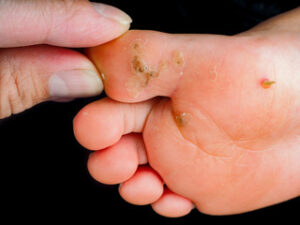Pesky Verruca
 Verrucae – what are they, what do they look like, how do you get them and how do you get rid of them?
Verrucae – what are they, what do they look like, how do you get them and how do you get rid of them?
A verruca is a wart on the foot caused by the Human Papilloma Virus (HPV).
It can look like a cauliflower floret if it is in a non-weight bearing area. If it is in a pressure area it will become flattened and may have a rough crumbly surface. Sometimes it may have little black dots in the centre.
There are a few ways to tell the difference between a corn and a verruca. If you squeeze the lump from side to side and it is painful, it is likely to be a verruca. If you can look closely and can see the skin lines, if they go around the lesion, it is likely to be a verruca, whereas if they go through it, it is likely to be a corn. Verrucae often have black dots in them.
If it has appeared where there is no pressure and sticks up from the skin, it is likely to be a verruca.
As a verruca is caused by a virus, you catch it from someone who either has a verruca or wart, or who is a carrier. As the virus lives longest in wet conditions, the most likely places to pick one up are showers, swimming pools, hotel bathrooms etc.
The virus enters through a tiny crack or break in your skin, usually when your immune system is distracted in some way, often through some sort of stress. This can be anything from exam time, to moving house, to having a row with someone close to you to, to having a cold or flu, to losing a pet – anything that causes distress. So the virus sneaks in and sets up home in your skin. It is a very clever virus and can “hide” itself from your immune system. When the stressful time is over or has lessened, your body may not realise that it has a job to do.
Because it is a virus, it is your immune system that deals with it – not the treatments that you may try. Here at Sole to Soul we usually go for the gentle option and treat verrucae by removing any excess hard skin around and over the verruca before irritating the tissues to give the immune system a nudge. It doesn’t need to be anything too severe or painful, just enough to be an irritant. We may use silver nitrate or essential oils such as lavender or tea tree.
If all goes well, eventually your immune system will wake up and do its job and the verruca will go.
Occasionally, if the gentle way doesn’t work, we may choose to use a stronger treatment which usually involves using an acid to create a chemical burn which will allow your body to recognise the invader. This is done very carefully to minimise the risk of scarring which can lead to long term problems. For this reason, surgical removal is generally a last resort.
In many cases, we advise that if the verruca isn’t causing any pain, to simply wait for it to resolve naturally.

